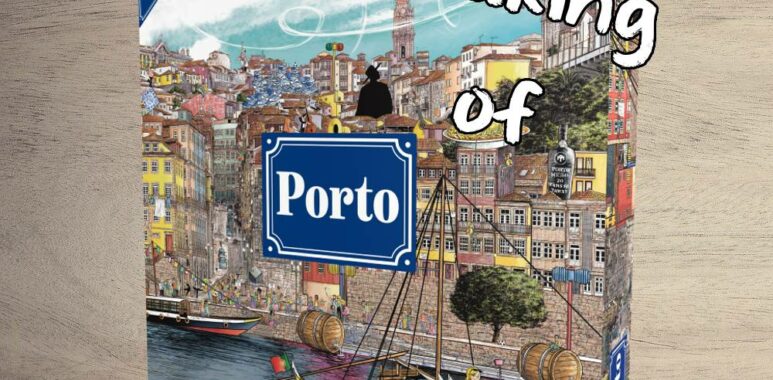
Porto, or Building an Iconic Riverfront “Co-operatively” Against Your Opponents
For many, the Easter vacations are just around the corner. After the gray wet and cold start of spring, a few warm and sunny days would be quite nice. So why not go to Porto over Easter? The Ribeira district right on the river is famous for its colorful houses.
But you can also let Porto come to you. Build colorful houses in the board game Porto from our Portuguese partner MEBO Games. The game has been published in German by HeidelBÄRen and is available in our online store and in well-stocked specialty stores.
In the following Designer Diary, the author Fábio Lima gives you an exciting insight into the development of the game.
I love Porto! I think it’s one of the most beautiful cities in the world, filled with history, culture, and dramatic cityscapes. When I studied there, I would often just sit near the river and contemplate how painfully beautiful it was — because I knew one day I would have to leave it behind.
I Love Ideas
The day I had the idea for Porto, I was seated on a terrace in Porto on vacation. I had been designing games for the last two years, games with sprawling thematics and mechanisms. However, I had never thought to design a game about Porto or even experiment with tile placement. On that day, though, I started thinking about it.
Later that day, on my way to pick up a friend at the airport, while stuck in traffic, it seemed obvious to me: A game about Porto should emphasize its iconic riverfront, so we would be building colored houses — and if you build floors, then it seemed logical to me that I should experiment with tile placement or floor placement (which is what I usually call it when explaining the game).
Design Checklist
I wanted the game to be a family game, yet fresh.
I wanted the game to be fluid, engaging and fast.
I wanted the game to be simple, yet filled with good decisions.
This was my design checklist.
But you know how sometimes you enter the supermarket with a shopping list and leave with more than you need in your bag? Well, that also happened here! During the development process with the team of MEBO Games, I was able to cross reference my initial checklist to make sure we wouldn’t leave the store with more in our bag than we wanted.
How can a game be fresh?! I always ask myself that. How can I use mechanisms that we often see and combine them in a way that makes it interesting? What are good decisions in a family game?
We toned down the design to only two choices on your turn: Draw cards or build floors. There was nothing new here, though, so how could we make it fresh?
To Draw or Not To Draw, That Is the Question
We determined that when you draw cards, you can draw any number of cards, taking into account that the total value of the drawn cards cannot exceed 3. (Cards have values between 1 and 3.) You can draw three 1s, or one 1 and one 2, or one 3. In theory, higher numbers are better, but you need to spend two cards when you build, so taking a 3 means you don’t have enough cards to immediately build in your next turn.
What you draw is your choice, as is when you draw and when you build. Wait one more turn, and that card may not be there. Take that 2 value card that you need, but take only one card because the market is filled with cards of value 2. Once again, it’s your choice. It’s a simple choice, but it has consequences.
To Build or Not To Build…Is the Difference Between Scoring or Not Scoring
You can build by spending two cards from your hand, but we wanted to give you options, so when you build you use the number of one of the cards to determine how many floors you build, and you use the color of the other card to determine the color of those floors. (Every card has a number and a color.) Suddenly, with only three cards in your hand, you have up to six possible options, and with four, up to ten options, so it’s your choice. You don’t need to have a lot of cards in hand to have options. You can build…or draw because those options on the market really suit you. Once again, it’s up to you.
When you build you shape the city. Building is intuitive, so you always start from the ground floor and build up to the top. When you arrive there, you place a roof tile and the game end comes near. There can never be two houses of the same color side by side, and all tiles in a house have to have the same color. Simple and straightforward.
Big decisions arrive when you have to decide where and how to build because the houses belong to all players, which means that you can start a house that someone else will finish. Will you open that opportunity? If so, where? In theory, you want to add on to buildings that already have floors built because when you build you get 1 point for each floor that exists on that building including the ones you have just built. Plus, the floors that you have built, if adjacent to other floors, give you extra points.
That said, four public contracts always lie face up in the middle of the board that you can claim when building, with those contracts giving you extra points if you meet their requirement, e.g., build two yellow floors, or use a red and a blue card when building, or finish a green building, etc.
So maybe instead of finishing that house and getting those juicy points, you will be building in another plot because by doing so you can meet the requirements of two public contracts at the same time. I guess by now you already know what I’m about to say: It’s your choice; we just give you options.
Why wouldn’t you always capitalize on the houses started by other players if by doing so you even meet the requirements of some public contracts? Well, you guessed it once again: There are other good options. Let me present to you the private contracts.
Haven’t I Said We Wanted to Give You Options?
At the beginning of the game, you receive five private contract cards; from those, you keep three. These cards give you extra points at the end of the game if their conditions are met, e.g., completing a pair of houses of a certain color on the board, completing all all houses on one side of the board, completing 1-3 houses of the same color, etc.
Because these cards are secret, other players don’t know what your plans are for the end of the game. They may guess it when you pass a great opportunity to score by building in a certain house or when you decide to start a new house of a certain color in another part of the board. You can even entice players to finish houses that will score your private cards; you can do that because when you build a ground floor, you collect and score the points of the token sitting there, then you place that token in an empty roof space. Thus, if you want to guarantee that that red house you have just started is finished by the end of the game, maybe you should place that 3-point token you just collected on the empty roof of that house and let others do the job.
Porto Is All About Positive Player Interaction
As you can imagine, Porto is a game in which your actions deeply impact the other players. However, this interaction is not destructive because if an opportunity is taken from you, another one will open up before your own eyes. Nothing is granted in this game. At the same time, you are never completely “eliminated” from the game.
After 45 minutes of card drawing, card playing and tile placement, the end of the game is triggered (after a certain number of houses are built, based on the number of players) and you’ll have built the iconic riverfront of Porto. All those points you have secured can be boosted by your private contracts. Very often, players switch places when they score their private contracts because if you did extremely well by taking advantage of all the opportunities on the board, probably you have ignored your private contracts and it’s at this moment when you’ll discover whether that was a good or foolish strategy.
Building Porto in Essen
It was a long ride to arrive here. Despite the design being simple, we had to work and rework every single rule of the game in order to guarantee that it was fluid, engaging and, above all, filled with good decisions every single turn.
Let me finish by praising the work of Luís Levy Lima, who has done an amazing job with his illustrations (which you can see in full scale on the back of the main board), bringing to the board several iconic elements of Porto and its rich culture.
I hope to see you all in Essen at SPIEL ’19 when we launch the game. I look forward to teaching and playing Porto with you in MEBO’s booth!
 Porto is by Orlando Sá and for 1–4 persons from 8 years and available from HeidelBÄR Games in German.
Porto is by Orlando Sá and for 1–4 persons from 8 years and available from HeidelBÄR Games in German.The family game contains 1 game rule, 1 game board, 1 start player tower, 75 floors, 15 first floors, 14 roofs, 4 scoring tiles, 4 game aid cards, 14 SP tiles, 4 scoring tiles, 50 building cards, 35 “Public Order” cards and 39 “Private Order” cards.


:strip_icc()/pic4231484.jpg)
:strip_icc()/pic4639052.jpg)
:strip_icc()/pic4636005.jpg)
:strip_icc()/pic4635752.jpg)
:strip_icc()/pic4635753.jpg)
:strip_icc()/pic4635750.jpg)
:strip_icc()/pic4636003.jpg)
:strip_icc()/pic4973055.jpg)
:strip_icc()/pic4974887.jpg)